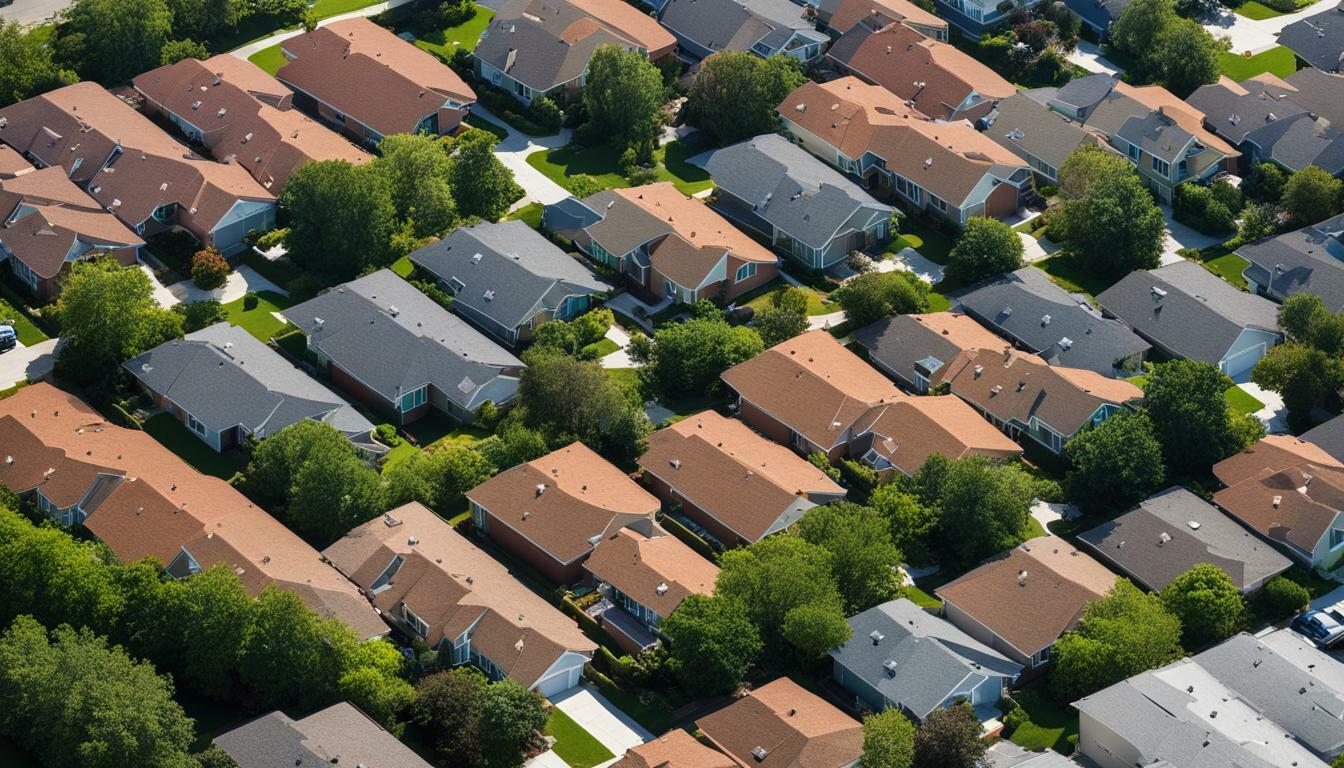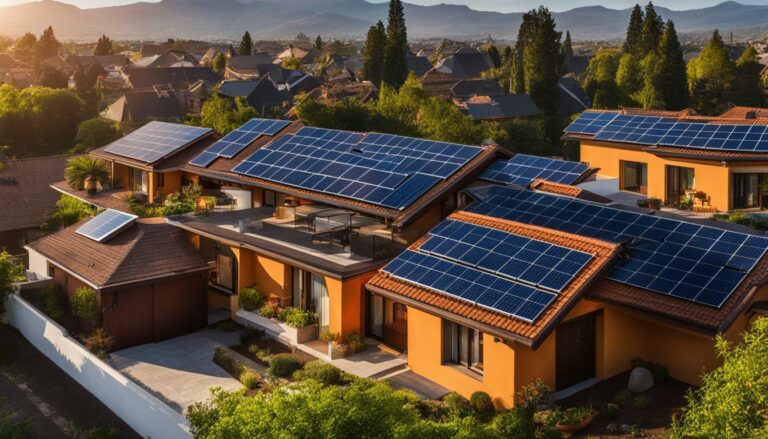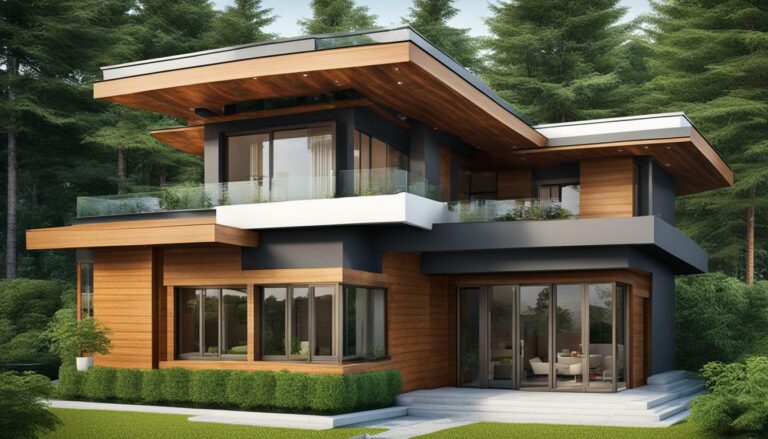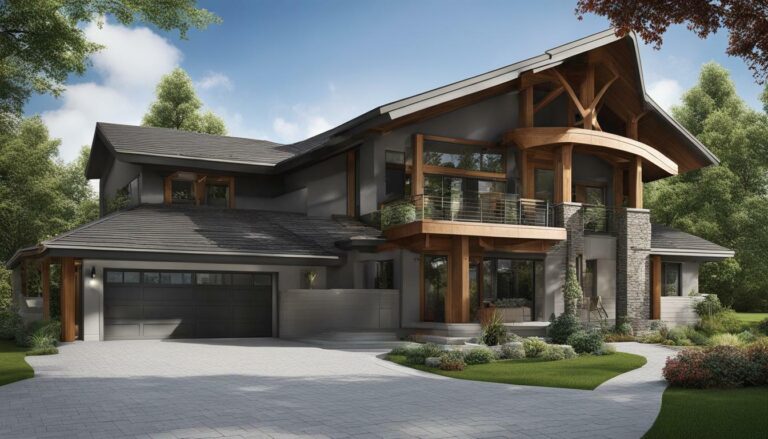Understanding Your Roofing Materials’ Carbon Footprint
As a homeowner concerned about your environmental impact, it is crucial to understand the carbon footprint of your roofing materials. Making informed decisions when it comes to choosing sustainable options can contribute to a greener future for our planet.
- Evaluating the environmental impact of roofing materials with life cycle analysis (LCA) is essential.
- Factors to consider when choosing eco-friendly roofing materials include embodied energy, durability, and recyclability.
- Metal roofs, particularly those made from aluminum, are environmentally friendly due to their low embodied energy and recyclability.
- Clay tiles provide energy efficiency and easy replaceability.
- Recycled shingles offer an affordable and long-lasting option for sustainable roofing.
Evaluating Roofing Materials’ Environmental Impact with Life Cycle Analysis (LCA)
Life cycle analysis (LCA) is a valuable tool used to assess the environmental footprint of competing roofing products. It provides a comprehensive evaluation of a product’s impact throughout its entire life cycle, including raw material extraction, manufacturing, transportation, installation, use, and end-of-life disposal.
By conducting an LCA, manufacturers, architects, and homeowners can make informed decisions about which roofing materials are the most environmentally friendly. LCA takes into account various factors such as energy consumption, greenhouse gas emissions, water usage, and waste generation, allowing for a holistic understanding of the environmental impact of different roofing options.
When evaluating roofing materials with LCA, it is essential to consider their embodied energy, which refers to the energy required for their production and transportation. Materials with high embodied energy, such as concrete or asphalt shingles, can have a significant environmental impact. On the other hand, materials like metal roofs, which have a low embodied energy and high recyclability, are considered more sustainable choices.
LCA Comparative Table: Environmental Impact of Roofing Materials
| Roofing Material | Embodied Energy | Recyclability | Greenhouse Gas Emissions |
|---|---|---|---|
| Metal Roofs | Low | High | Low |
| Clay Tiles | Moderate | Low | Low |
| Recycled Shingles | Low | Low | Low |
In addition to embodied energy, durability and recyclability are crucial factors to consider when choosing eco-friendly roofing materials. Durable materials, such as clay tiles and metal roofs, have longer lifespans, reducing the need for frequent replacements and minimizing waste. Furthermore, the recyclability of a roofing material ensures that it can be repurposed or recycled at the end of its life, reducing the demand for new raw materials and diverting waste from landfills.
By leveraging the insights gained from life cycle analysis, homeowners can select roofing materials that align with their sustainability goals and contribute to a greener future. Whether it’s opting for energy-efficient metal roofs, sustainable clay tiles, or long-lasting recycled shingles, every decision made in the roofing industry can have a positive impact on the environment.
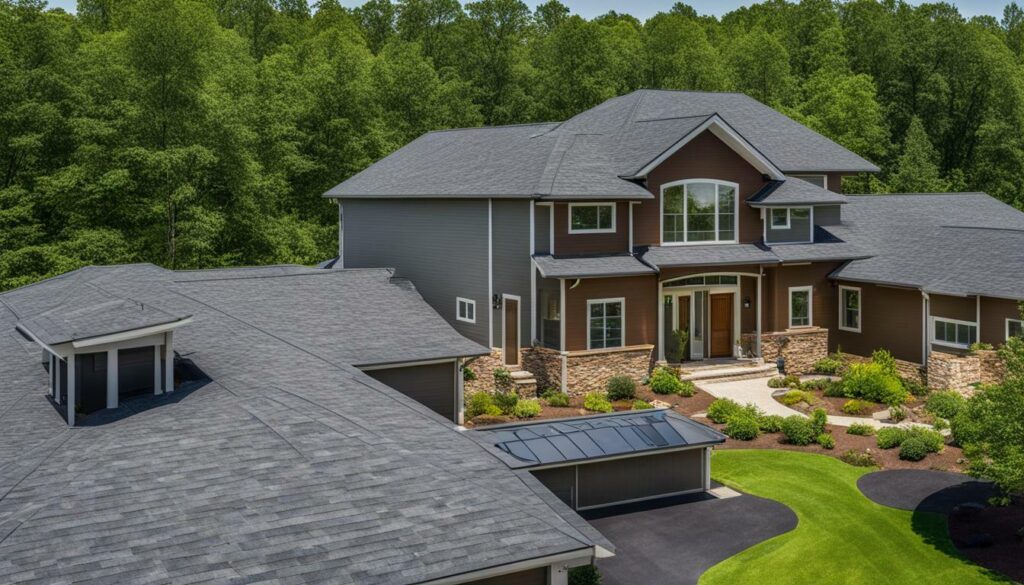
When choosing eco-friendly roofing materials, it is essential to consider factors such as embodied energy, durability, and recyclability. These factors play a crucial role in determining the environmental impact of your roofing choice and can contribute to a sustainable future.
1. Embodied Energy: Embodied energy refers to the total energy consumed during the production, transport, installation, and disposal of a roofing material. Opting for materials with low embodied energy can significantly reduce your carbon footprint. For example, metal roofs, like aluminum, have a lower embodied energy compared to traditional asphalt shingles. They require less energy to manufacture and can be recycled at the end of their lifespan.
2. Durability: The durability of a roofing material is crucial for long-term sustainability. Choosing a material that can withstand harsh weather conditions and requires minimal maintenance can help reduce waste and future replacements. Clay tiles, for instance, are known for their exceptional durability and longevity. They can resist damage from UV rays and high winds, making them an energy-efficient choice.
3. Recyclability: A key consideration when selecting an eco-friendly roofing material is its recyclability. Opting for materials that can be recycled at the end of their lifespan ensures a circular economy and minimizes waste. Recycled shingles, made from salvaged materials, are an affordable and sustainable option. They not only reduce landfill waste but also have a lifespan of over 50 years, making them a long-lasting choice.
Table: Comparison of Eco-Friendly Roofing Materials
| Roofing Material | Embodied Energy | Durability | Recyclability |
|---|---|---|---|
| Metal Roofs (Aluminum) | Low | High | Recyclable |
| Clay Tiles | Medium | High | Not widely recyclable |
| Recycled Shingles | Low | High | Not widely recyclable |
By considering these factors, you can make an informed decision when selecting eco-friendly roofing materials. Remember that each material has its own advantages and limitations, so it’s important to choose the one that aligns with your specific needs and goals.
“When selecting an eco-friendly roofing material, it’s crucial to consider its embodied energy, durability, and recyclability. Opting for materials with low embodied energy, high durability, and recyclability can help reduce your environmental impact and contribute to a sustainable future.”
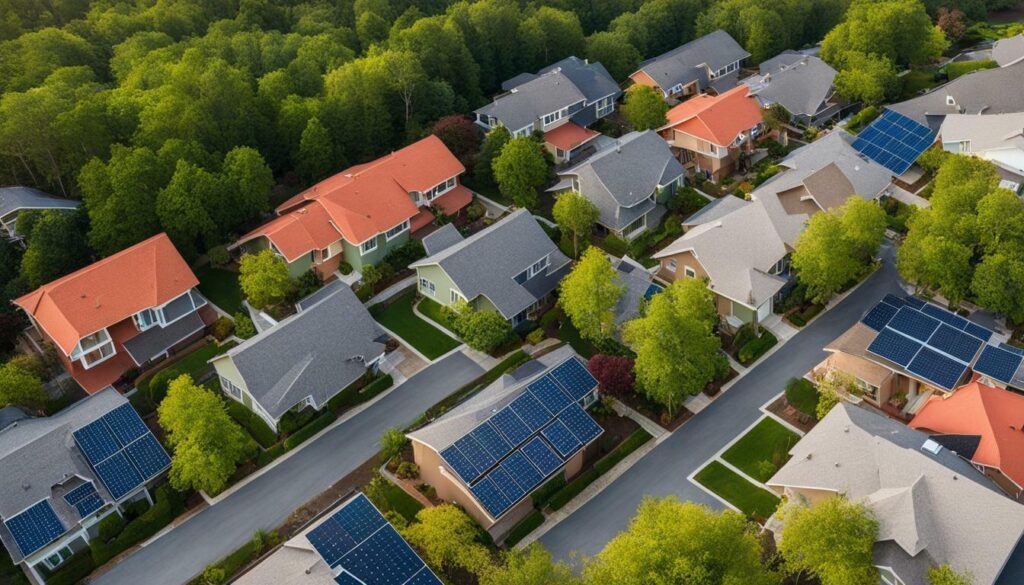
Environmental Benefits of Metal Roofs
Metal roofs, especially those made from aluminum, offer significant environmental benefits due to their low embodied energy and recyclability. The production of metal roofing materials requires less energy and emits fewer carbon emissions compared to other options. This low embodied energy contributes to a reduced carbon footprint, making metal roofs an environmentally friendly choice for homeowners.
Additionally, metal roofs are highly recyclable, which further enhances their sustainability. At the end of their lifespan, metal roof materials can be recycled and reused, minimizing waste and reducing the demand for new resources. According to a study by the Metal Construction Association, more than 95% of aluminum roofing materials are recycled, making it an excellent choice for those looking to minimize their environmental impact.
Energy Efficiency and Durability
In addition to their low embodied energy and recyclability, metal roofs are known for their energy efficiency and durability. Metal reflects sunlight, reducing heat absorption and keeping the interior of the building cooler. This can lead to lower energy consumption for cooling purposes, resulting in reduced energy costs and carbon emissions.
Furthermore, metal roofs have a long lifespan, often lasting two to three times longer than traditional roofing materials. Their durability ensures that they require less frequent replacement, reducing waste and the need for new materials. This long-lasting performance makes metal roofs not only environmentally friendly but also cost-effective in the long run.
| Advantages of Metal Roofs | |
|---|---|
| Low embodied energy | Metal roofs require less energy for production, reducing their environmental impact. |
| Recyclability | More than 95% of aluminum roofing materials can be recycled, minimizing waste. |
| Energy efficiency | Metal roofs reflect sunlight, reducing heat absorption and lowering energy consumption for cooling. |
| Durability | Metal roofs have a longer lifespan, resulting in less frequent replacement and reduced waste. |
Considering the environmental benefits of metal roofs, along with their energy efficiency and durability, homeowners have a sustainable roofing option that can contribute to a greener future. By selecting roofing materials that offer low embodied energy, recyclability, and long-lasting performance, individuals can reduce their carbon footprint and save on energy costs in the long run.
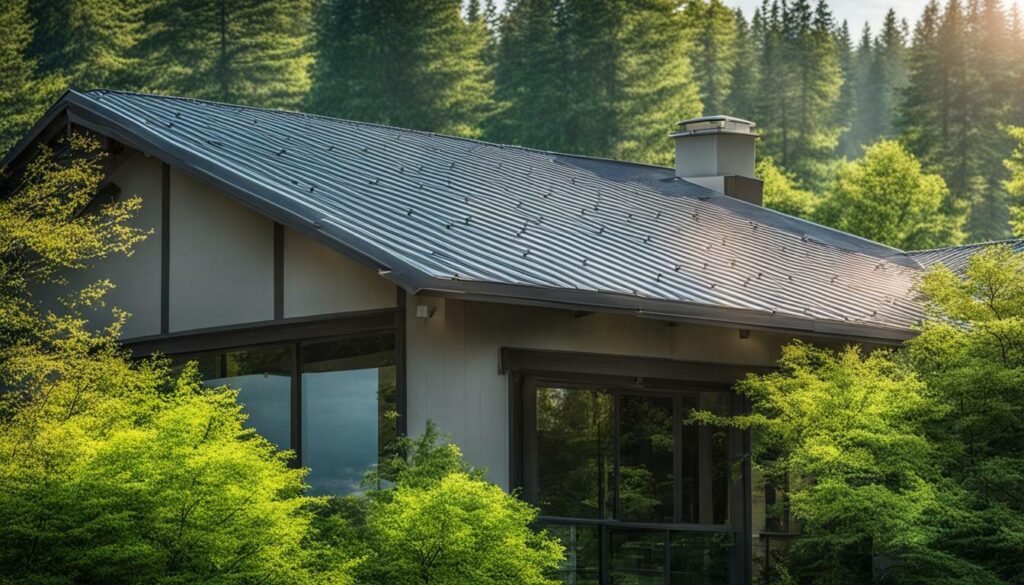
Clay tile roofs are known for their energy efficiency and durability, making them a sustainable choice for homeowners. These roofs offer numerous benefits that contribute to a greener and more eco-friendly living environment.
One of the key advantages of clay tile roofs is their energy efficiency. Clay tiles have natural thermal insulating properties, which help regulate temperature fluctuations inside the home. This means that during hot summer months, clay tile roofs can keep the interior cooler, reducing the need for excessive air conditioning. Similarly, in colder seasons, the tiles provide an additional layer of insulation, keeping the warmth inside and reducing heating costs. This energy efficiency translates into lower energy consumption and reduced carbon emissions.
Furthermore, clay tile roofs are highly durable and long-lasting. When properly maintained, they can withstand harsh weather conditions, including wind, rain, and even hail. Their resilience ensures that homeowners do not have to replace or repair their roofs frequently, reducing waste and the overall environmental impact. Additionally, clay tiles are easy to replace if needed, offering a cost-effective solution for homeowners.
Overall, clay tile roofs provide a sustainable roofing option with their energy efficiency and durability. Their long lifespan and minimal maintenance requirements make them an attractive choice for environmentally conscious homeowners. By opting for clay tiles, you can not only reduce your carbon footprint but also enjoy the aesthetic appeal and natural benefits they bring to your home.
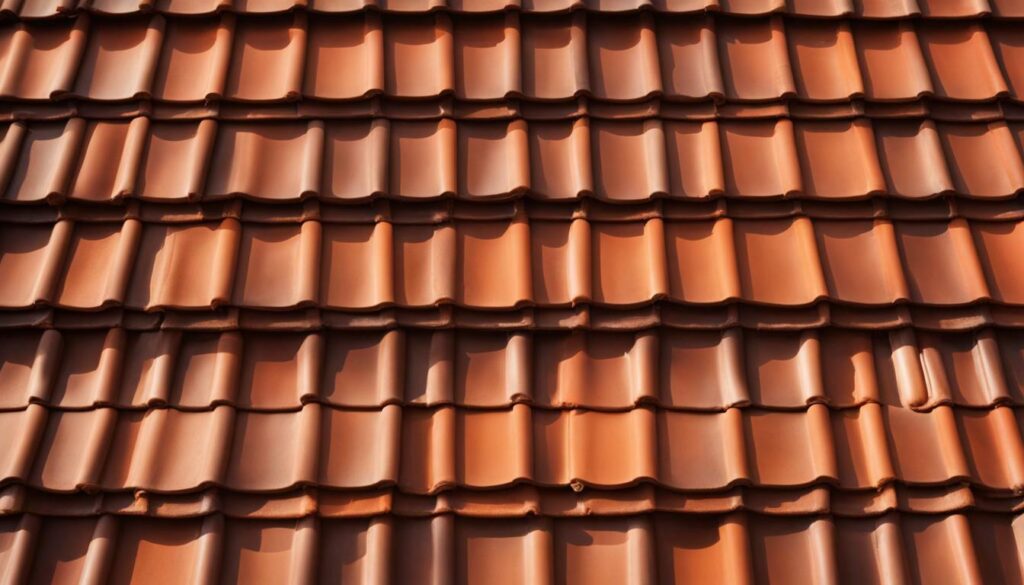
Clay tile roofs offer an energy-efficient and durable solution for homeowners seeking sustainable choices.
Affordable and Long-Lasting Recycled Shingle Roofs
Recycled shingle roofs offer an affordable and long-lasting solution for homeowners looking for sustainable roofing materials. These roofs are made from discarded shingles that have been recycled and transformed into new roofing products. By repurposing old shingles, the production of new materials is reduced, minimizing waste and conserving resources.
One of the key advantages of recycled shingle roofs is their affordability. Compared to other eco-friendly roofing options, such as metal or clay tiles, recycled shingles are often more cost-effective. This makes them a popular choice for budget-conscious homeowners who want to reduce their environmental footprint without breaking the bank.
Not only are recycled shingle roofs affordable, but they also boast impressive longevity. These roofs are designed to withstand harsh weather conditions and can last over 50 years with proper maintenance. This extended lifespan reduces the need for frequent replacements, resulting in long-term cost savings for homeowners.
With their affordability and durability, recycled shingle roofs are an attractive option for those seeking sustainable roofing materials. By choosing recycled shingles, homeowners contribute to the reduction of waste and promote the use of recycled materials in construction. This helps protect the environment and supports a more circular economy.
| Benefits of Recycled Shingle Roofs |
|---|
| 1. Affordable |
| 2. Long-lasting |
| 3. Environmentally friendly |
| 4. Reduces waste and promotes recycling |
When considering roofing options for your home, it’s essential to weigh the benefits of recycled shingle roofs against other materials. While they may not offer the same sleek appearance as metal roofs or the natural charm of clay tiles, recycled shingles provide a cost-effective and sustainable alternative.

“Choosing a recycled shingle roof was one of the best decisions I made for my home. Not only did it save me money, but it also gave me peace of mind knowing that I’m doing my part for the environment. It looks great, and I don’t have to worry about replacing it for decades to come.” – Sarah, homeowner
In summary, recycled shingle roofs offer an affordable and long-lasting option for homeowners seeking sustainable roofing materials. Their cost-effectiveness and durability make them an attractive choice, while their use of recycled materials contributes to waste reduction and promotes recycling. Consider the benefits of recycled shingle roofs when making informed decisions for a greener and more eco-conscious home.
Cool Roofs: Reflecting Sunlight and Reducing Heat Absorption
Cool roofs provide an effective solution for reducing heat absorption and conserving energy by reflecting sunlight. These roofs, typically made of light-colored materials or coated with reflective substances, help to keep buildings cooler and reduce the need for excessive air conditioning. By reducing heat transfer to the interior, cool roofs can make a significant impact on energy consumption and contribute to a more sustainable future.
When sunlight hits a cool roof, the reflective properties of the materials prevent a large portion of the solar radiation from being absorbed. Instead, the radiation is reflected back into the atmosphere. This process reduces the amount of heat transferred into the building, resulting in lower indoor temperatures and decreased cooling loads. As a result, energy consumption for air conditioning can be significantly reduced, leading to cost savings and a smaller carbon footprint.
According to the U.S. Department of Energy, cool roofs can reduce roof surface temperatures by up to 50 degrees Fahrenheit, leading to energy savings of 10-15% in cooling costs. Additionally, cool roofs can help mitigate the urban heat island effect, which refers to the higher temperatures experienced in urban areas due to the abundance of concrete and asphalt that absorb and radiate heat. By reflecting sunlight instead of absorbing it, cool roofs can help to lower ambient temperatures and improve overall comfort in cities.
Benefits of Cool Roofs:
- Reduced energy consumption for cooling
- Lower indoor temperatures and increased comfort
- Cost savings on air conditioning
- Decreased carbon footprint
- Less strain on power grids during hot weather
- Alleviation of the urban heat island effect
With the increasing demand for sustainable building practices, cool roofs are gaining popularity as an eco-friendly solution. They provide tangible benefits for homeowners and building owners, such as energy savings and increased comfort, while also contributing to a more environmentally conscious society. So, whether you are constructing a new building or planning to replace your existing roof, considering a cool roof can be a wise and responsible choice.
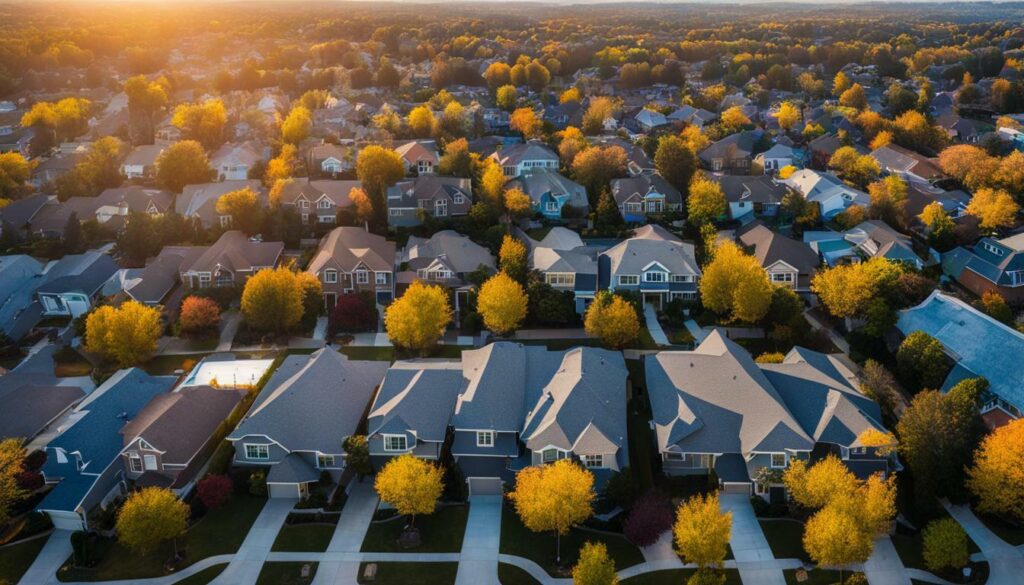
Wood shingle roofs are both renewable and durable, offering homeowners an eco-friendly and long-lasting roofing option. When considering sustainable roofing materials, wood shingles stand out for their minimal environmental impact and longevity. Unlike other roofing materials that deplete finite resources, wood shingles are made from renewable resources such as cedar and redwood.
One of the key benefits of wood shingle roofs is their durability. When properly installed and maintained, they can last for decades, providing reliable protection and aesthetic appeal. With their natural resistance to insects and decay, wood shingles have a proven track record of longevity, making them a cost-effective investment in the long run.
Wood shingle roofs offer a timeless beauty that complements various architectural styles, blending seamlessly into natural surroundings.
In addition to their renewable and durable qualities, wood shingles also provide excellent insulation, contributing to energy efficiency in homes. Their natural insulation properties help regulate temperature, keeping homes warmer in the winter and cooler in the summer. This not only enhances comfort but also reduces energy consumption, leading to lower utility bills and a smaller carbon footprint.
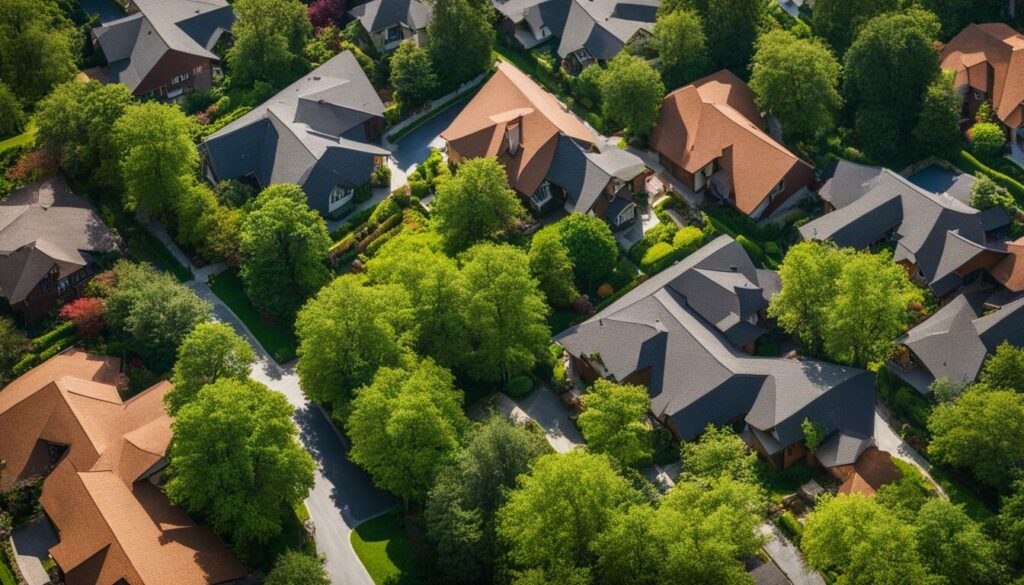
When opting for wood shingle roofs, it’s important to choose FSC-certified (Forest Stewardship Council) products to ensure responsible forestry practices. FSC-certified wood shingles come from sustainably managed forests, promoting environmental balance and supporting local communities. By selecting this eco-friendly roofing option, homeowners can contribute to the preservation of forests and promote sustainable living.
| Benefits of Wood Shingle Roofs |
|---|
| Renewable and sustainable |
| Durable and long-lasting |
| Excellent insulation properties |
| Natural beauty that blends with surroundings |
| Promotes responsible forest management |
In summary, wood shingle roofs offer homeowners an environmentally conscious choice that combines renewable resources, durability, energy efficiency, and aesthetic appeal. By installing wood shingles, you can enjoy a beautiful and long-lasting roof while minimizing your environmental impact. Make an informed decision and choose wood shingle roofs to contribute to a sustainable future.
Metal Roofs: A Sustainable, Energy-Efficient, and Recycled Option
Metal roofs are a sustainable and energy-efficient option that is made from recycled materials, providing homeowners with an environmentally friendly roofing choice. Understanding the carbon footprint of roofing materials is crucial for those concerned about reducing their environmental impact. With life cycle analysis (LCA), homeowners can evaluate the environmental footprint of various roofing products and make informed decisions for a sustainable future.
When choosing a roofing material, there are several factors to consider. One important aspect is embodied energy, which refers to the total energy consumed in the production, transportation, and installation of the material. Metal roofs have a significantly lower embodied energy compared to other options, making them an eco-friendly choice. Additionally, metal roofs are highly durable, with a lifespan that can exceed 50 years, reducing the need for frequent replacements and minimizing waste.
| Benefits of Metal Roofs: |
|---|
| Low embodied energy |
| Long lifespan |
| Recyclable |
Another advantage of metal roofs is their recyclability. At the end of their lifespan, metal roofing materials can be recycled into new products, reducing the demand for virgin resources and minimizing the environmental impact. This closed-loop recycling process contributes to a more sustainable construction industry.
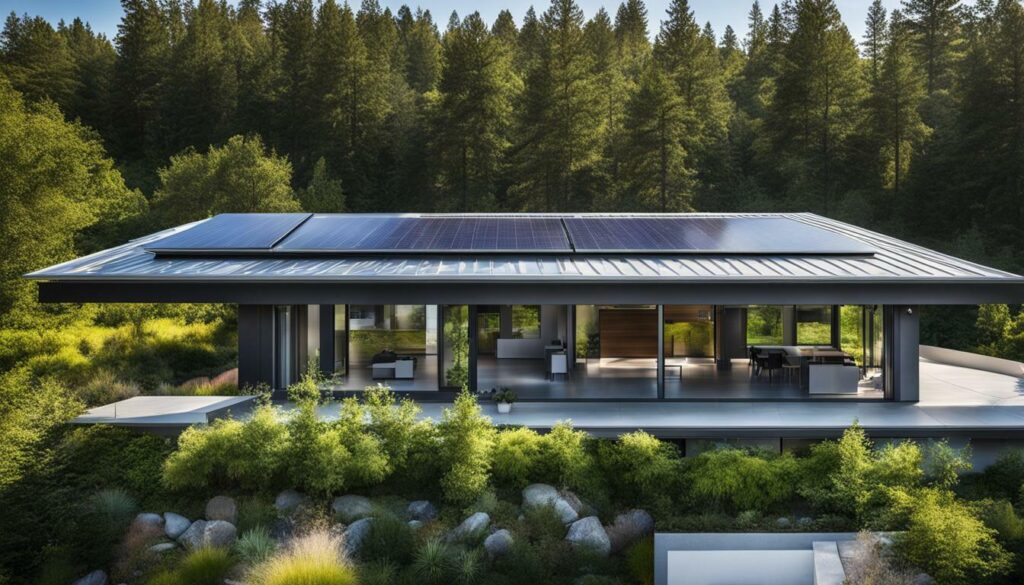
Testimonials:
“We recently installed a metal roof, and it’s been a fantastic decision. Not only do we feel good about using recycled materials, but our energy bills have also decreased significantly. The roof’s durability and low maintenance have been a major plus.” – John D., Homeowner
In summary, metal roofs offer homeowners a sustainable, energy-efficient, and recycled option for their roofing needs. With lower embodied energy, long lifespans, and recyclability, metal roofs are an environmentally friendly choice that contributes to reducing carbon emissions and saving energy costs. By making informed decisions and choosing eco-friendly roofing materials, homeowners can play a valuable role in building a sustainable future.
Solar Roofs: Alternative Energy Source and Property Value Increase
Solar roofs offer an alternative energy source and can increase property value while reducing carbon emissions and dependence on fossil fuels. With advancements in technology and increasing environmental awareness, solar energy has become a popular choice for homeowners looking to reduce their carbon footprint and save on energy costs. By harnessing the power of the sun, solar roofs generate clean and renewable energy, making them an attractive option for sustainable living.
Installing solar panels on your roof has numerous benefits. Not only do solar roofs provide an environmentally friendly energy source, but they also offer significant financial advantages. By producing your own electricity, you can reduce or eliminate your reliance on traditional energy sources, resulting in lower utility bills. Additionally, many states offer incentives and tax credits for homeowners who install solar panels, further offsetting the initial cost.
Moreover, a solar roof can increase the value of your property. According to a study conducted by the Lawrence Berkeley National Laboratory, homes equipped with solar energy systems have a higher resale value compared to those without. Potential buyers are increasingly interested in sustainable features, and solar roofs are seen as a desirable and forward-thinking investment. Not only does this enhance the marketability of your home, but it also positions it as a sustainable and eco-friendly choice for potential buyers.
Investing in a solar roof is a long-term commitment that pays off both financially and environmentally. It allows you to take control of your energy consumption, reduce your carbon footprint, and potentially increase the value of your property. By harnessing the power of the sun, solar roofs offer a sustainable and innovative solution for homeowners looking to make a positive impact on the planet while enjoying the benefits of renewable energy.
| Benefits of Solar Roofs |
|---|
| Alternative energy source |
| Reduction in carbon emissions |
| Lower energy costs |
| Increased property value |
| Financial incentives and tax credits |
| Sustainable and eco-friendly investment |
Testimonial
“Installing solar panels on my roof was one of the best decisions I made for both my wallet and the environment. Not only do I save money on my monthly energy bills, but I also feel good knowing that I’m reducing my carbon footprint. Plus, my home’s value has increased significantly, thanks to the added appeal of solar energy. I highly recommend considering a solar roof for anyone looking to make a sustainable investment.”
With the increasing demand for renewable energy solutions, solar roofs have become a viable and beneficial option for homeowners. By embracing solar power, you can contribute to a cleaner and more sustainable future while enjoying the financial advantages and increased property value that come with it.
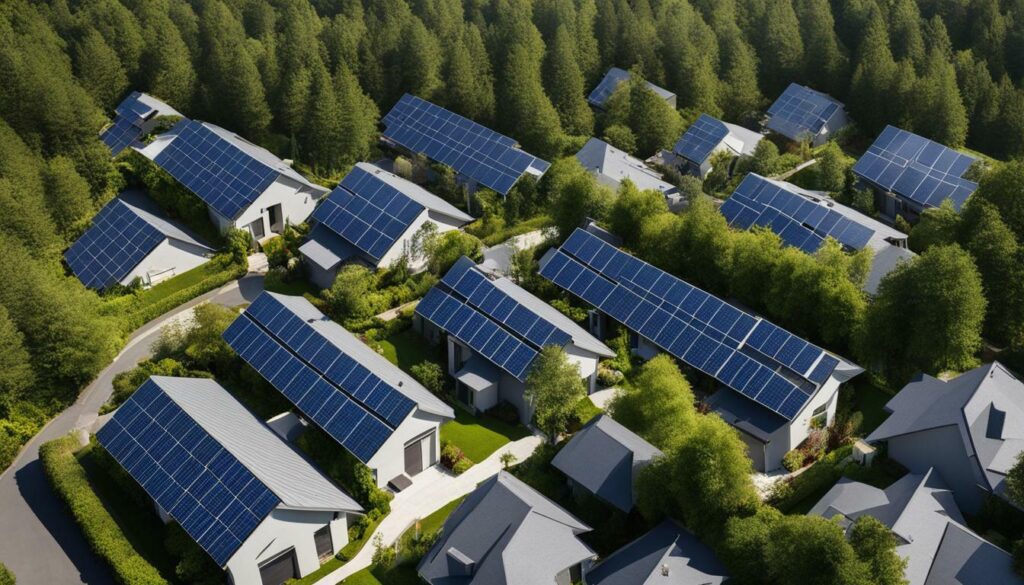
By selecting eco-friendly roofing materials, you can actively contribute to reducing carbon emissions and saving energy costs for a more sustainable future. Understanding the carbon footprint of roofing materials is crucial for homeowners who are concerned about their environmental impact. Life cycle analysis (LCA) is used to evaluate the environmental footprint of different roofing products, taking into account the entire lifecycle of the materials.
When choosing a roofing material, several factors should be considered. Embodied energy, which is the energy required to manufacture and transport the material, is an important consideration. Opting for materials with low embodied energy, such as metal roofs made from aluminum, can significantly reduce the environmental impact. Additionally, the durability and recyclability of the roofing material play a crucial role in sustainability. Materials like clay tiles, known for their energy efficiency and ease of replacement, are a sustainable choice.
For those looking for cost-effective and long-lasting options, recycled shingle roofs are a great choice. These roofs are made from recycled materials and can last over 50 years, making them an excellent investment. Cool roofs, designed to reflect sunlight and reduce heat absorption, are another eco-friendly option. They help conserve energy and mitigate the urban heat island effect.
Wood shingle roofs offer both renewal and durability. They are sourced from sustainable forests, making them an environmentally friendly choice. Metal roofs, besides being long-lasting and energy-efficient, are also made from recycled materials, reducing waste and lowering environmental impact. For those interested in alternative energy sources, solar roofs provide clean energy and have the potential to increase the value of your property.
In conclusion, choosing eco-friendly roofing materials is beneficial for reducing carbon emissions, saving energy costs, and building a more sustainable future. By considering factors such as embodied energy, durability, and recyclability, homeowners can make informed decisions that have a positive environmental impact. With a wide range of options available, it is now easier than ever to contribute to a greener and more sustainable world.
FAQ
Q: What is the carbon footprint of roofing materials?
A: The carbon footprint of roofing materials refers to the total greenhouse gas emissions produced throughout their manufacturing, transportation, installation, use, and disposal processes.
Q: How is the environmental impact of roofing materials evaluated?
A: The environmental impact of roofing materials is evaluated using life cycle analysis (LCA) to assess their overall energy consumption, emissions, and potential for waste generation.
Q: What factors should I consider when choosing a roofing material?
A: Factors to consider when choosing a roofing material include embodied energy (energy required for production), durability, and recyclability.
Q: Are metal roofs considered environmentally friendly?
A: Yes, metal roofs, such as aluminum, are considered environmentally friendly due to their low embodied energy and recyclability.
Q: What are the benefits of clay tile roofs?
A: Clay tile roofs are energy efficient and easily replaceable, making them an excellent choice for sustainable roofing.
Q: Why should I consider recycled shingle roofs?
A: Recycled shingle roofs are affordable and can last over 50 years, offering a cost-effective and sustainable roofing option.
Q: What are cool roofs?
A: Cool roofs are designed to reflect sunlight and reduce heat absorption, contributing to energy conservation and combating urban heat island effects.
Q: Are wood shingle roofs renewable and durable?
A: Yes, wood shingle roofs are renewable and durable, making them an environmentally friendly choice for sustainable roofing.
Q: Why are metal roofs considered a sustainable option?
A: Metal roofs are long-lasting, energy-efficient, and made from recycled materials, making them a sustainable choice for eco-conscious homeowners.
Q: What are the benefits of solar roofs?
A: Solar roofs provide an alternative energy source and can increase property value while reducing reliance on fossil fuels and carbon emissions.
Q: Why is choosing eco-friendly roofing materials important?
A: Choosing eco-friendly roofing materials helps to reduce carbon emissions, save energy costs, and contribute to building a sustainable future.
